Sedimentary Sequence, Evolution Model and Petroleum Geological Significance of Forced Regression: A Case Study of the Miocene Zhujiang Formation of the Pearl River Mouth Basin in the Northern South China Sea
Abstract
:1. Introduction
2. Geological Setting and Stratigraphy
3. Data and Methodology
4. Results
4.1. Depositional Systems or Facies Associations
4.1.1. Core Lithofacies Characteristics
4.1.2. Sedimentary Sequence Characteristics of Single Well
4.1.3. Seismic Facies Characteristics
4.2. Sequence Stratigraphic Systems and Depositional Evolution
4.2.1. Sedimentary Sequence Characteristics in the Depositional Trends
4.2.2. Sedimentary Sequence Characteristics in the Vertical Depositional Trends
4.2.3. Trajectory of Shoreline Migration
5. Discussion
5.1. Evolution Model of Forced Regression
5.2. Significance for Petroleum Geology
6. Conclusions
- (1)
- The falling stage systems tract of the Zhujiang Formation in the PRMB present an offlap high-angle oblique foreset reflection structure that inferred shelf-edge delta without topset beds in the depositional trends. The drilling and logging data show many reverse cycles which are combined by prodelta mud, distal bar, mouth bar, and underwater distributary channel in the falling stage systems tract.
- (2)
- The features of bioturbation, horizontal burrows, muddy strip deformation, slide and slump, which are typical in slope areas, can be observed in the cores of the falling stage systems tract of the Zhujiang Formation in the PRMB. Turbidite fan deposits characterized by strong amplitude mound reflection structure are developed in the downdip direction of the front of the falling stage systems tract.
- (3)
- The falling stage systems tract of the Zhujiang Formation in the PRMB is formed in the sedimentary background with low accommodation space, and the parasequence is formed during the ascension half-cycle of rising base level (relative sea-level). The falling stage systems tract present a stacking pattern with progradational to aggradational parasequence set. The migration trajectory of shoreline shows terraced downtrend in the direction of basin.
- (4)
- The falling stage systems tract are comparatively thick in the western part of the study area which is a shelf-edge delta, and, here, the main estuaries are abundant. There is a transition from the western part to the eastern part of the study area which are strip-shaped, wave-dominated shoreface sands; here, a small shelf-edge delta and the sub-estuary are plentiful. The falling stage systems tract was formed during the descent phase of relative sea-level. Five sets of foreset beds controlled by high-frequency relative sea-level cycles were developed, therefore ordinal regressive overlap can be observed for the five sets of shelf-edge deltas in the direction of the sea.
- (5)
- The favourable reservoirs which are located close to the upper boundary of the falling stage systems tract and the basal surface of forced regression are sandbodies of the shelf-edge delta front and wave-dominated shoreface sands and the sandbodies of the turbidite fan. Those sandbodies are favourable places for the formation of lithologic oil–gas reservoirs by means of good trap sealing conditions, excellent oil–gas reserving performance, and effective oil source communication of fracture system.
Author Contributions
Funding
Institutional Review Board Statement
Informed Consent Statement
Data Availability Statement
Acknowledgments
Conflicts of Interest
References
- Miall, A.D. Whither stratigraphy? Sediment. Geol. 1995, 100, 5–20. [Google Scholar] [CrossRef]
- Posamentier, H.W.; Allen, G.P.; James, D.P.; Tesson, M. Forced regressions in a sequence stratigraphic framework: Concepts, examples, and exploration significance. Am. Assoc. Pet. Geol. Bull. 1992, 76, 1687–1709. [Google Scholar]
- Hunt, D.; Tucker, M.E. Stranded parasequences and the forced regressive wedge systems tract: Deposition during base-level fall-reply. Sediment. Geol. 1995, 95, 147–160. [Google Scholar] [CrossRef]
- Plint, A.G.; Nummedal, D. The falling stage systems tract: Recognition and importance in sequence-stratigraphic analysis. In Sedimentary Responses to Forced Regressions; Geological Society of London Special Publication; Hunt, D., Gawthorpe, R.L., Eds.; Geological Society of London: London, UK, 2000; Volume 172, pp. 1–17. [Google Scholar]
- Catuneanu, O. Sequence stratigraphy of clastic systems: Concepts, merits, and pitfalls. J. Afr. Earth Sci. 2002, 35, 1–43. [Google Scholar] [CrossRef]
- Catuneanu, O. Principles of Sequence Stratigraphy; Elsevier: Amsterdam, The Netherlands, 2006; pp. 1–343. [Google Scholar]
- Catuneanu, O.; Zecchin, M. High-resolution sequence stratigraphy of clastic shelves II: Controls on sequence development. Mar. Pet. Geol. 2013, 39, 26–38. [Google Scholar] [CrossRef]
- Catuneanu, O. Model-independent sequence stratigraphy. Earth-Sci. Rev. 2019, 188, 312–388. [Google Scholar] [CrossRef]
- Zecchin, M.; Caffau, M.; Tosi, L.; Civile, D.; Brancolini, G.; Rizzetto, F.; Roda, C. The impact of Late Quaternary glacio-eustasy and tectonics on sequence development: Evidence from both uplifting and subsiding settings in Italy. Terra Nova 2010, 22, 324–329. [Google Scholar] [CrossRef]
- Zecchin, M.; Catuneanu, O.; Rebesco, M. High-resolution sequence stratigraphy of clastic shelves IV: High-latitude settings. Mar. Pet. Geol. 2015, 68, 427–437. [Google Scholar] [CrossRef]
- Maravelis, A.G.; Catuneanu, O.; Nordsvan, A.; Landenberger, B.; Zelilidis, A. Interplay of tectonism and eustasy during the Early Permian icehouse: Southern Sydney Basin, southeast Australia. Geol. J. 2018, 53, 1372–1403. [Google Scholar] [CrossRef]
- Wu, J.F.; Xu, Q.; Zhu, Y.H. Generation and evolution of the shelf-edge delta in Oligocene and Miocene of Baiyun Sag in the South China Sea. Earth Sci. J. China Univ. Geosci. 2010, 35, 681–690, (In Chinese with English abstract). [Google Scholar]
- Xu, Q.; Wang, Y.M.; Lv, M.; Wang, D.; Li, D.; Wang, Y.F. Identification of the shelf margin delta in sequence stratigraphic frameworks and its significance: A case study of the Baiyun Sag, South China Sea. Oil Gas Geol. 2011, 32, 733–742, (In Chinese with English abstract). [Google Scholar]
- Zhu, Y.H.; Zhu, W.L.; Xu, Q.; Wu, J.F. Sedimentary response to shelf-edge delta and slope deep-water fan in 13.8 Ma of Miocene epoch in Pearl River Mouth Basin. J. Cent. South Univ. (Sci. Technol.) 2011, 42, 3827–3834, (In Chinese with English abstract). [Google Scholar]
- Qin, C.G.; Shi, H.S.; Zhang, Z.T.; Gao, P.; Xu, H.; Qu, L.; Liu, D.L. Sedimentary characteristics and hydrocarbon exploration potential along the SQ21.0 sequence shelf-break zone on Panyu low-uplift and the north slop of Baiyun sag, Pearl River Mouth Basin. China Offshore Oil Gas 2011, 23, 14–18, (In Chinese with English abstract). [Google Scholar]
- Liu, B.J.; Pang, X.; Yan, C.Z.; Liu, J.; Lian, S.Y.; He, M.; Shen, J. Evolution of the Oligocene-Miocene shelf slope-break zone in the Baiyun deep-water area of the Pearl River Mouth Basin and its significance in oil-gas exploration. Acta Pet. Sin. 2011, 32, 234–242, (In Chinese with English abstract). [Google Scholar]
- Yi, X.F.; Zhang, C.M.; Li, S.H.; Du, J.Y. Identification marks and depositional models of the shelf-margin delta from NSQ2 of the Pearl River Mouth Basin, China. J. Chengdu Univ. Technol. (Sci. Technol. Ed.) 2012, 39, 257–261, (In Chinese with English abstract). [Google Scholar]
- Yi, X.F.; Zhang, C.M.; Li, S.H.; Du, J.Y.; Luo, M.; Li, X.Y. Comparison between shelf-margin delta of 21 Ma and 13.8 Ma in Pearl River Mouth Basin. Oil Gas Geol. 2014, 35, 670–678, (In Chinese with English abstract). [Google Scholar]
- Xu, S.H.; Wang, Y.M.; He, M.; Du, J.Y.; Chen, W.T.; Qin, C.Y.; Wang, L.L. Recognition criteria and genesis of falling stage systems tract. J. Cent. South Univ. (Sci. Technol.) 2016, 47, 531–540, (In Chinese with English abstract). [Google Scholar]
- Chen, W.T.; Shi, H.S.; Du, J.Y.; He, M. Formation conditions and development model of stratigraphic-lithologic traps in shelf break zone, Pearl River Mouth Basin: Zhujiang Formation as an example. Pet. Geol. Exp. 2016, 38, 619–627, (In Chinese with English abstract). [Google Scholar]
- Yu, Y.; Zhang, C.M.; Zhu, R.; Du, J.Y.; Huang, Y.R.; Wang, L. Recognition characteristics and hydrocarbon significance of falling stage systems tract. Acta Sedimentol. Sin. 2019, 37, 345–355, (In Chinese with English abstract). [Google Scholar]
- Hao, F.; Sun, Y.C.; Li, S.T.; Zhang, Q.M. Overpressure retardation of organic-matter maturation and petroleum generation-A case study from the Yinggehai and Qiongdongnan Basins, South China Sea. AAPG Bull. 1995, 79, 551–562. [Google Scholar]
- Hao, F.; Li, S.T.; Gong, Z.S.; Yang, J.M. Thermal regime, inter-reservoir compositional heterogeneities, and reservoir-filling history of the Dongfang Gas Field, Yinggehai Basin, South China Sea: Evidence for episodic fluid injections in overpressured basins? AAPG Bull. 2000, 84, 607–626. [Google Scholar]
- Zhou, D.; Yao, B.C. Tectonics and Sedimentary Basins of the South China Sea: Challenges and Progresses. J. Earth Sci. 2009, 20, 1–12. [Google Scholar] [CrossRef]
- Wang, Y.F.; Wang, Y.M.; Xu, Q.; Li, D.; Zhuo, H.T.; Zhou, W. The early-middle Miocene submarine fan system in the Pearl River Mouth Basin, South China Sea. Pet. Sci. 2012, 9, 1–9. [Google Scholar] [CrossRef] [Green Version]
- Chen, S.Z.; Pei, C.M. Geology and geochemistry of source rocks of the Eastern Pearl River Mouth Basin, South China Sea. J. Southeast Asian Earth Sci. 1993, 81, 393–406. [Google Scholar]
- Zhang, C.G.; Yang, H.C.; Chen, Y.; Ji, M.; Wang, K.; Yang, D.S.; Han, Y.X.; Sun, Y.H. The Baiyun sag: A giant rich gas-generation sag in the deepwater area of the Pearl River Mouth Basin. Nat. Gas Ind. 2014, 34, 11–25, (In Chinese with English abstract). [Google Scholar]
- Ma, B.J.; Wu, S.G.; Sun, Q.L.; Mi, L.J.; Wang, Z.Z.; Tian, J. The late Cenozoic deep-water channel system in the Baiyun sag, Pearl River Mouth Basin: Development and tectonic effects. Deep-Sea Res. Part II 2015, 122, 226–239. [Google Scholar] [CrossRef]
- Yu, Y.; Zhang, C.M.; Wang, L.; Li, S.H.; Hursthouse, A.; Huang, Y.R.; Cao, T.T. Sedimentary characteristics and genetic mechanism of a deep-water channel system in the Zhujiang Formation of Baiyun Sag, Pearl River Mouth Basin. Deep-Sea Res. Part I Oceanogr. Res. Pap. 2021, 168, 1–19. [Google Scholar] [CrossRef]
- Huang, C.J.; Zhou, D.; Sun, Z.; Chen, C.M.; Hao, H.J. Deep crustal structure of Baiyun Sag, Northern South China Sea revealed from deep seismic reflection profile. Chin. Sci. Bull. 2005, 50, 1131–1138. [Google Scholar] [CrossRef]
- Sun, Z.; Pang, X.; Zhong, Z.H.; Zhou, D.; Chen, C.M.; Hao, H.J.; He, M.; Huang, C.J. Dynamics of Tertiary tectonic evolution of the Baiyun Sag in the Pearl River Mouth Basin. Earth Sci. Front. 2005, 12, 489–498, (In Chinese with English abstract). [Google Scholar]
- Sun, Z.; Zhong, Z.H.; Keep, M.; Zhou, D.; Cai, D.S.; Li, X.S.; Wu, S.M.; Jiang, J.Q. 3D analogue modeling of the South China Sea: A discussion on Breakup pattern. J. Asian Earth Sci. 2009, 34, 544–556. [Google Scholar] [CrossRef]
- Pang, X.; Chen, C.M.; Peng, D.J.; Zhou, D.; Shao, L.; He, M.; Liu, B.J. Basic geology of Baiyun deep-water area in the Northern South China Sea. China Offshore Oil Gas 2008, 20, 215–222, (In Chinese with English abstract). [Google Scholar]
- Zhou, W.; Gao, X.Z.; Wang, Y.M.; Zhuo, H.T.; Zhu, W.L.; Xu, Q.; Wang, Y.F. Seismic geomorphology and lithology of the early Miocene Pearl River Deepwater fan system in the Pearl River Mouth Basin, Northern South China Sea. Mar. Pet. Geol. 2015, 68, 449–469. [Google Scholar] [CrossRef]
- Huang, C.Y.; Xia, K.Y.; Yuan, P.B.; Chen, P.G. Structural evolution from Paleocene extension to latest Miocene-Recent arc-continent collision offshore Taiwan: Comparison with on land geology. J. Asian Earth Sci. 2001, 19, 619–639. [Google Scholar] [CrossRef]
- Zhou, W.; Wang, Y.M.; Gao, X.Z.; Zhu, W.L.; Xu, Q.; Xu, S.; Cao, J.Z.; Wu, J. Architecture, evolution history and controlling factors of the Baiyun submarine canyon system from the middle Miocene to Quaternary in the Pearl River Mouth Basin, northern South China Sea. Mar. Pet. Geol. 2015, 67, 389–407. [Google Scholar] [CrossRef]
- Lüdmann, L.; Wong, H.K.; Wang, P.X. Plio-Quaternary sedimentation processes and neotectonics of the northern continental margin of the South China Sea. Mar. Geol. 2001, 172, 331–358. [Google Scholar] [CrossRef]
- Pang, X.; Chen, C.M.; Peng, D.J.; Zhu, M.; Shu, Y.; He, M.; Shen, J.; Liu, B.J. Sequence stratigraphy of deep-water fan system of Pearl River, South China Sea. Earth Sci. Front. 2007, 14, 220–229, (In Chinese with English abstract). [Google Scholar] [CrossRef]
- Zhu, W.; Huang, B.; Mi, L.; Wilkins, R.W.T.; Fu, N.; Xiao, X. Geochemistry, origin, and deep-water exploration potential of natural gases in the Pearl River Mouth and Qiongdongnan Basins, South China Sea. AAPG Bull. 2009, 93, 741–761. [Google Scholar] [CrossRef]
- Qin, G.Q. Late Cenozoic sequence stratigraphy and sea-level changes in Pearl River Mouth Basin, South China sea. China Offshore Oil Gas 2002, 16, 1–10, (In Chinese with English abstract). [Google Scholar]
- Li, X.Y.; Zhang, C.M.; Zhang, S.F.; Zhu, R.; Luo, M.; Shi, H.S.; Du, J.Y. Neogene sequence subdivision and its development pattern in Pearl River Mouth Basin. J. Oil Gas Technol. 2012, 34, 47–52, (In Chinese with English abstract). [Google Scholar]
- Zhu, R.; Zhang, C.M.; Du, J.Y.; Zhang, S.F.; Li, X.Y. Controls of Neogene sea level change on sand bodies in the Pearl River Mouth Basin. Geol. J. China Univ. 2015, 21, 685–693, (In Chinese with English abstract). [Google Scholar]
- Haq, B.U.; Hardenbol, J.; Vail, P.R. Mesozoic and Cenozoic chronostratigraphy and cycles of sea-level change. In Sea Level Changes–An Integrated Approach, SEPM Special Publication; Wilgus, C.K., Hastings, B.S., Kendall, C.G., Posamentier, H.W., Ross, C.A., Van Wagoner, J.C., Eds.; SEPM Society for Sedimentary Geology: Broken Arrow, OK, USA, 1988; Volume 42, pp. 71–108. [Google Scholar]
- Pang, X.; Chen, C.M.; Shao, L.; Wang, C.S.; Zhu, M. Baiyun Movement, a Great Tectonic Event on the Oligocene-Miocene Boundary in the Northern South China Sea and Its Implications. Geol. Rev. 2007, 53, 145–150, (In Chinese with English abstract). [Google Scholar]
- Liu, H.; Wang, Y.M.; Wang, Y. Depositional slope break in shallow marine shelf setting and its control on regional forced regressive wedge systems tract. Acta Sedimentol. Sin. 2011, 29, 906–916, (In Chinese with English abstract). [Google Scholar]
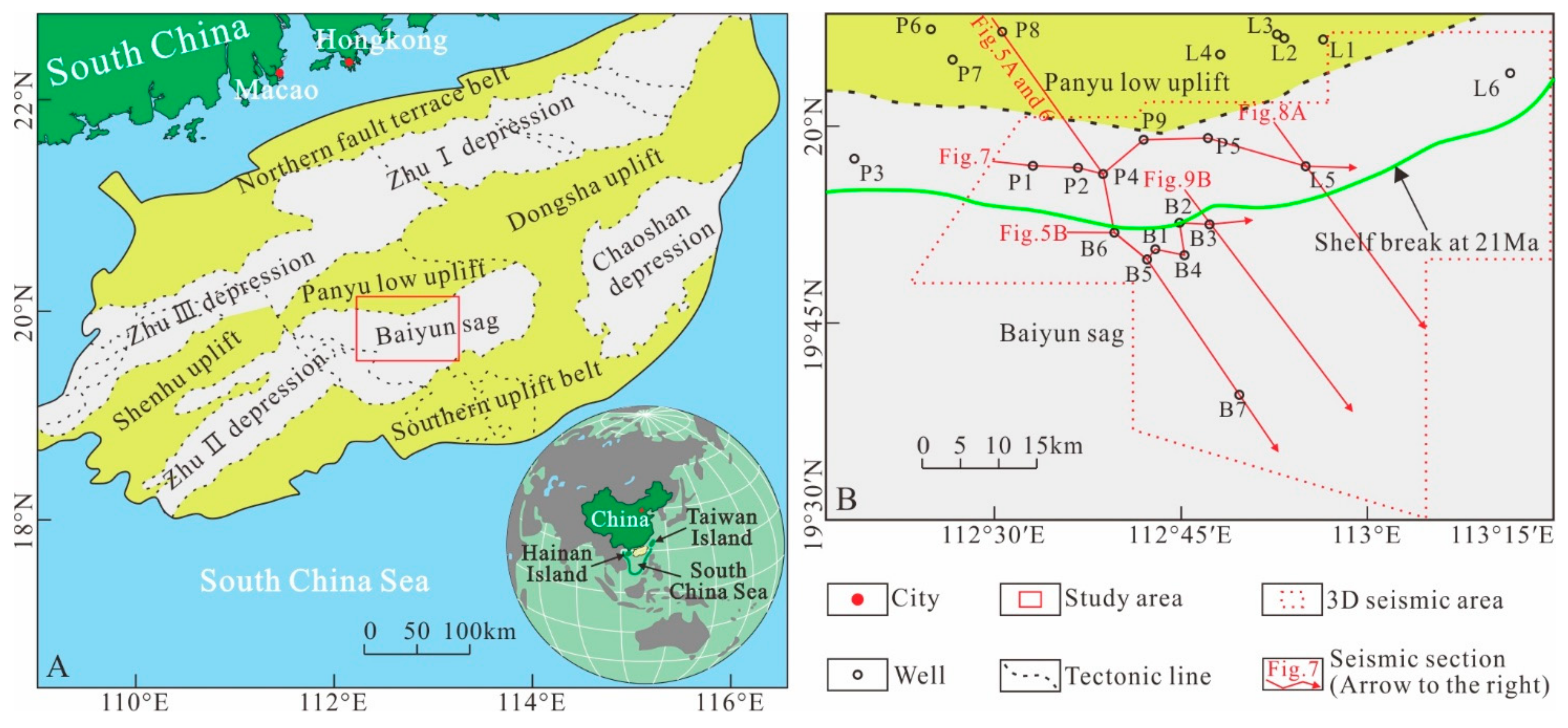
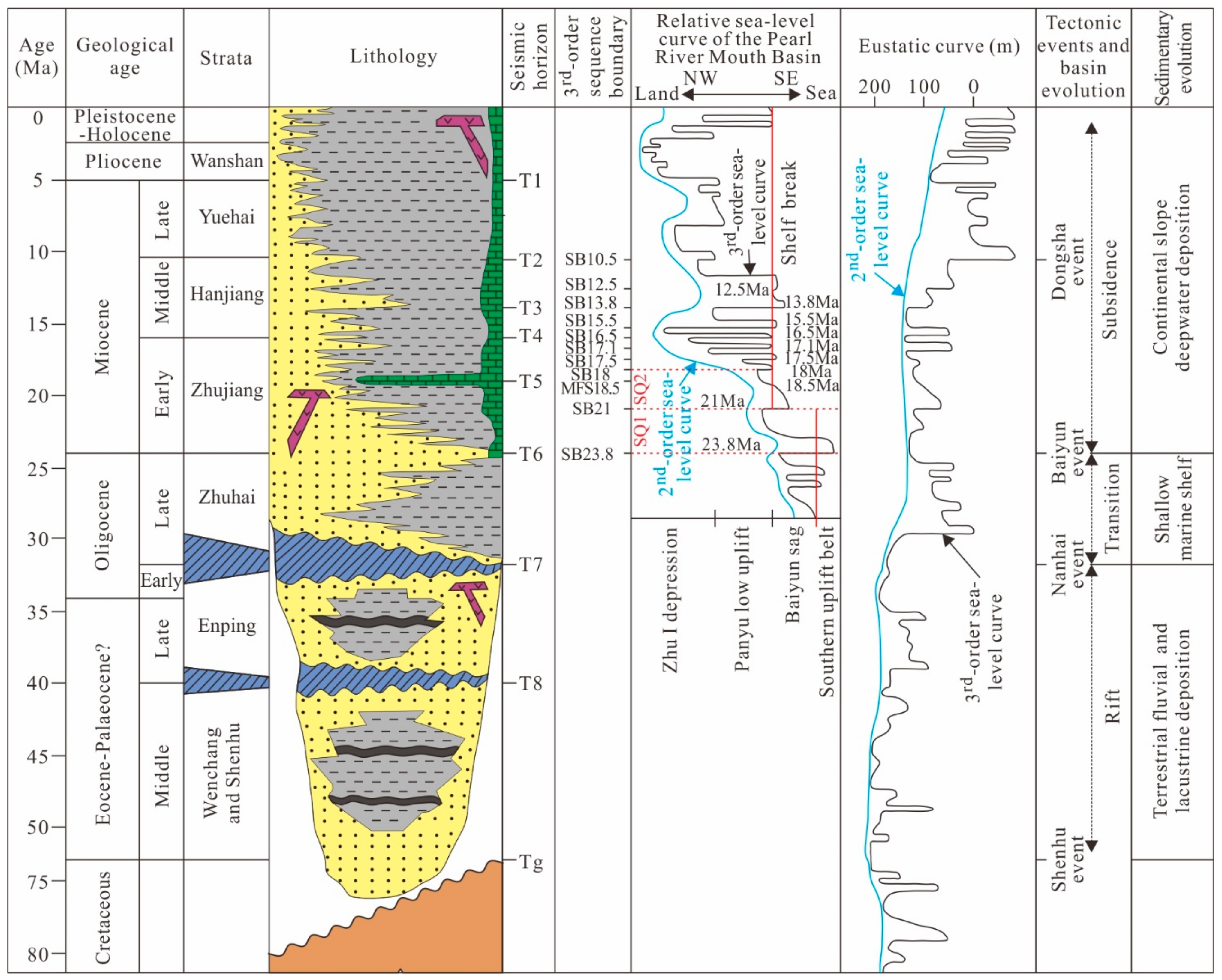
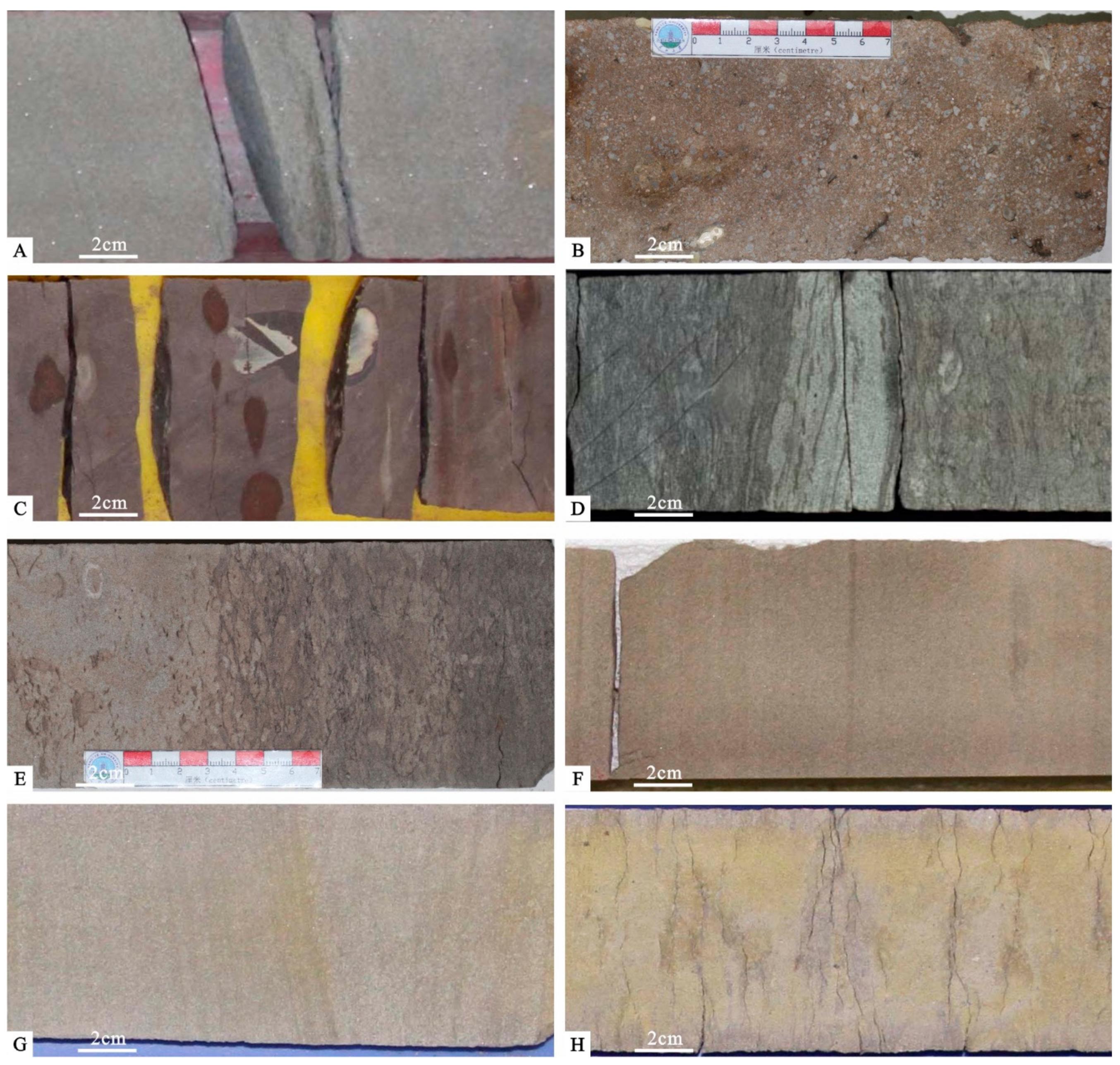

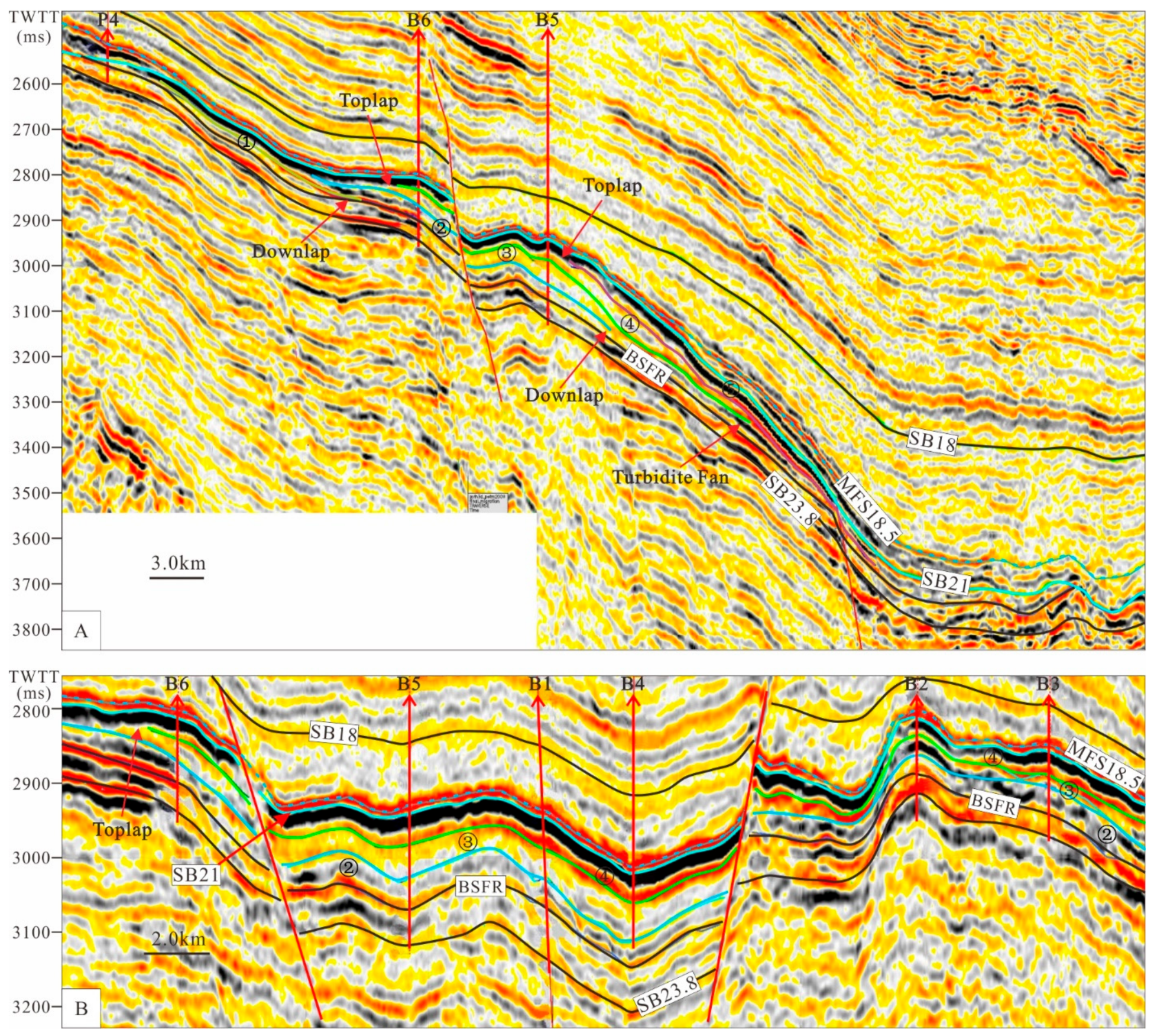
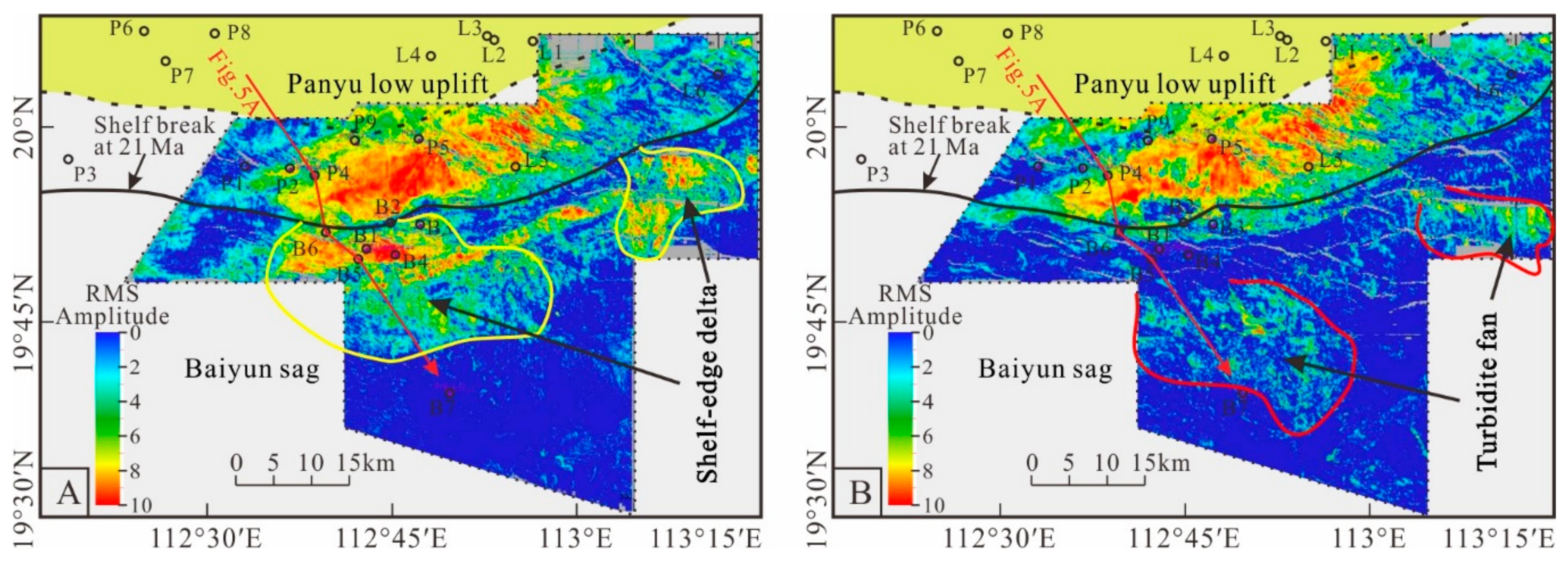
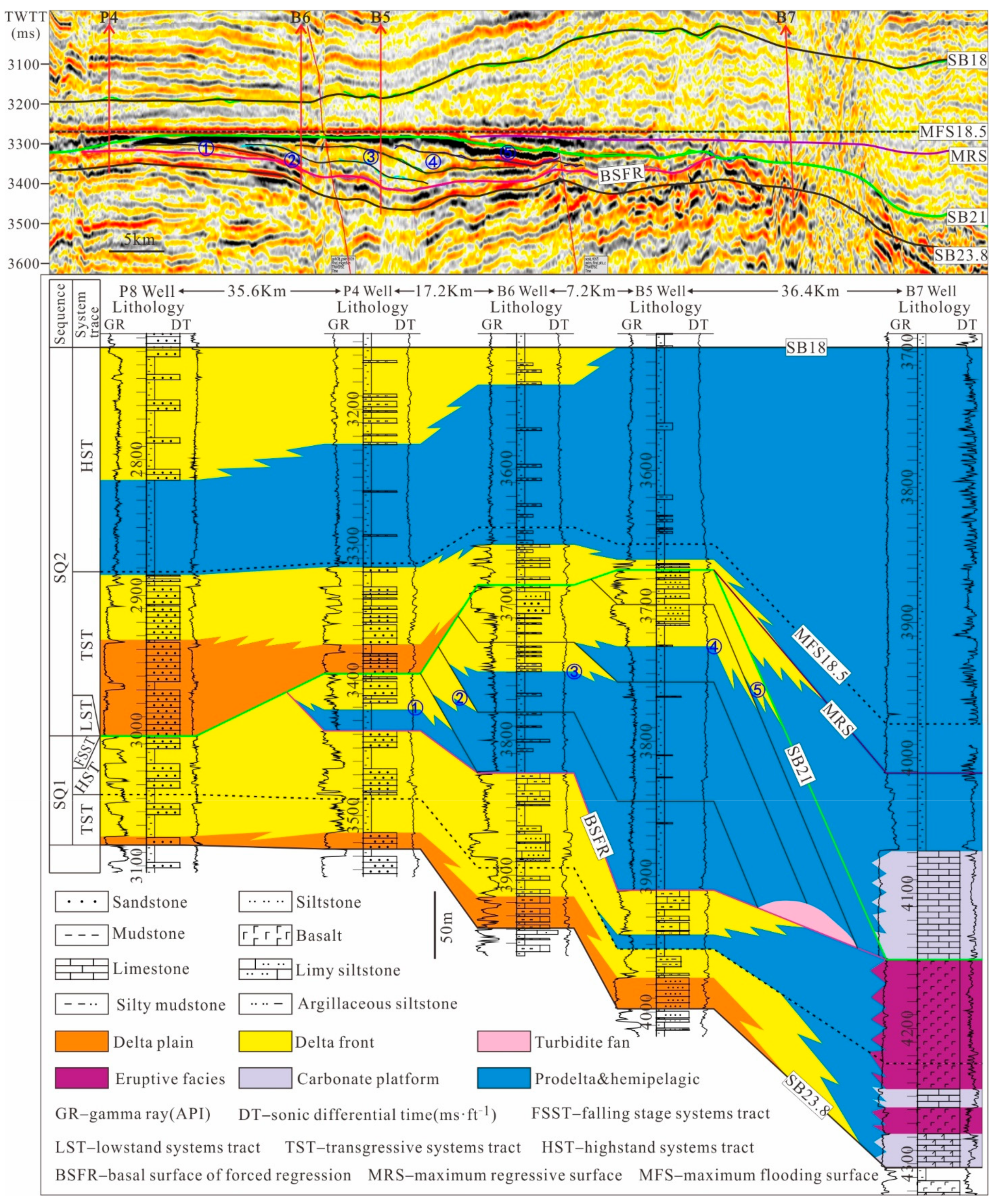
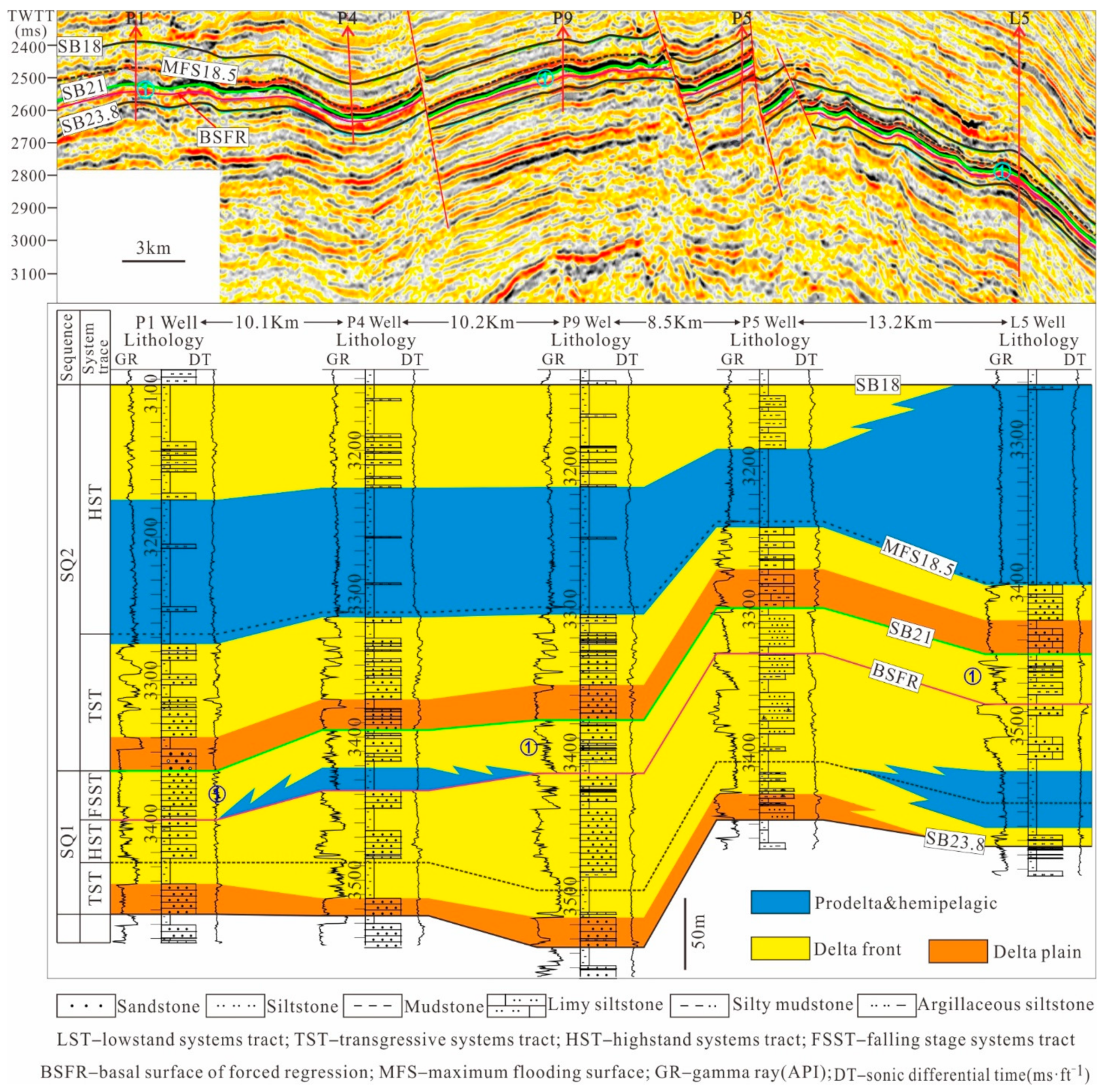
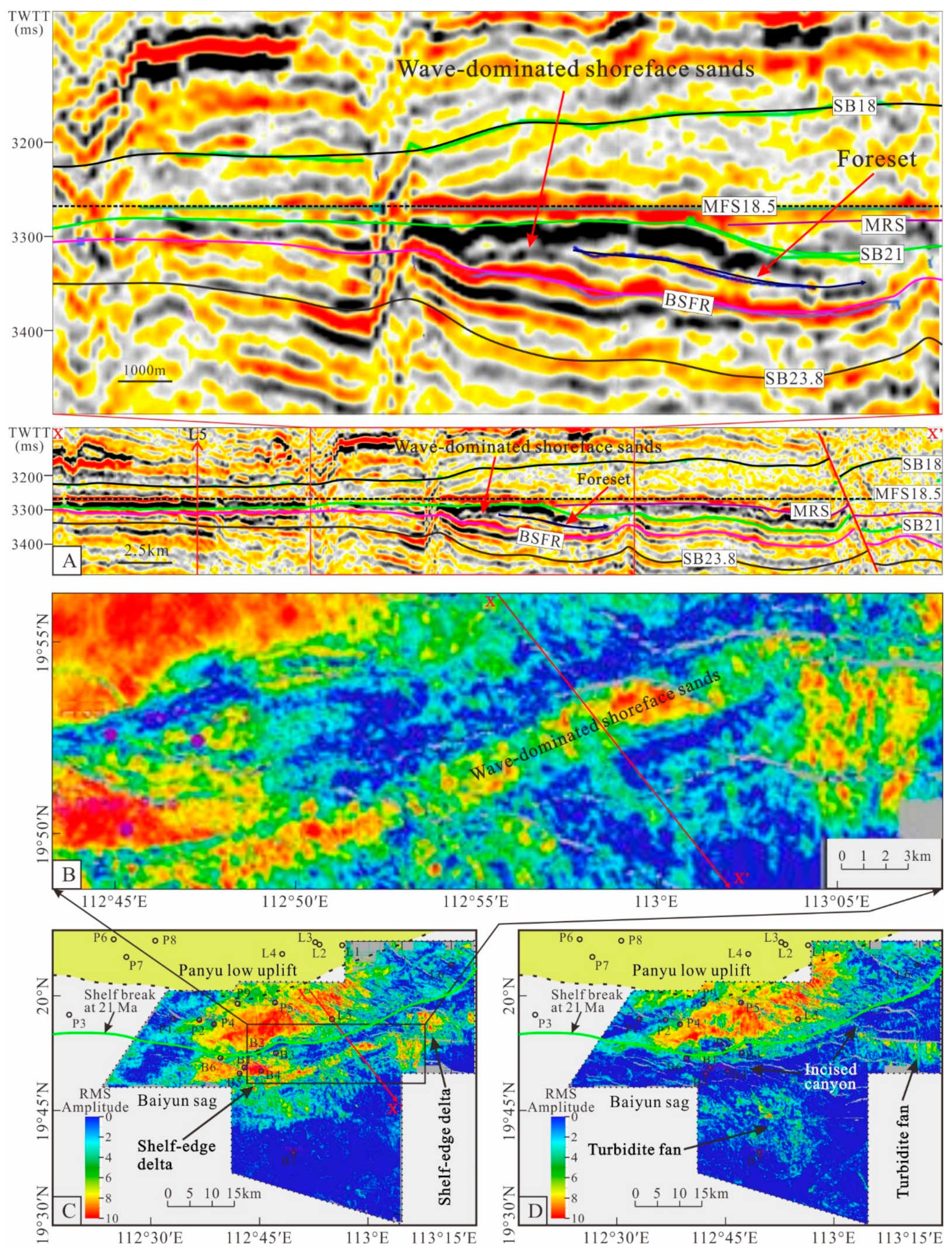
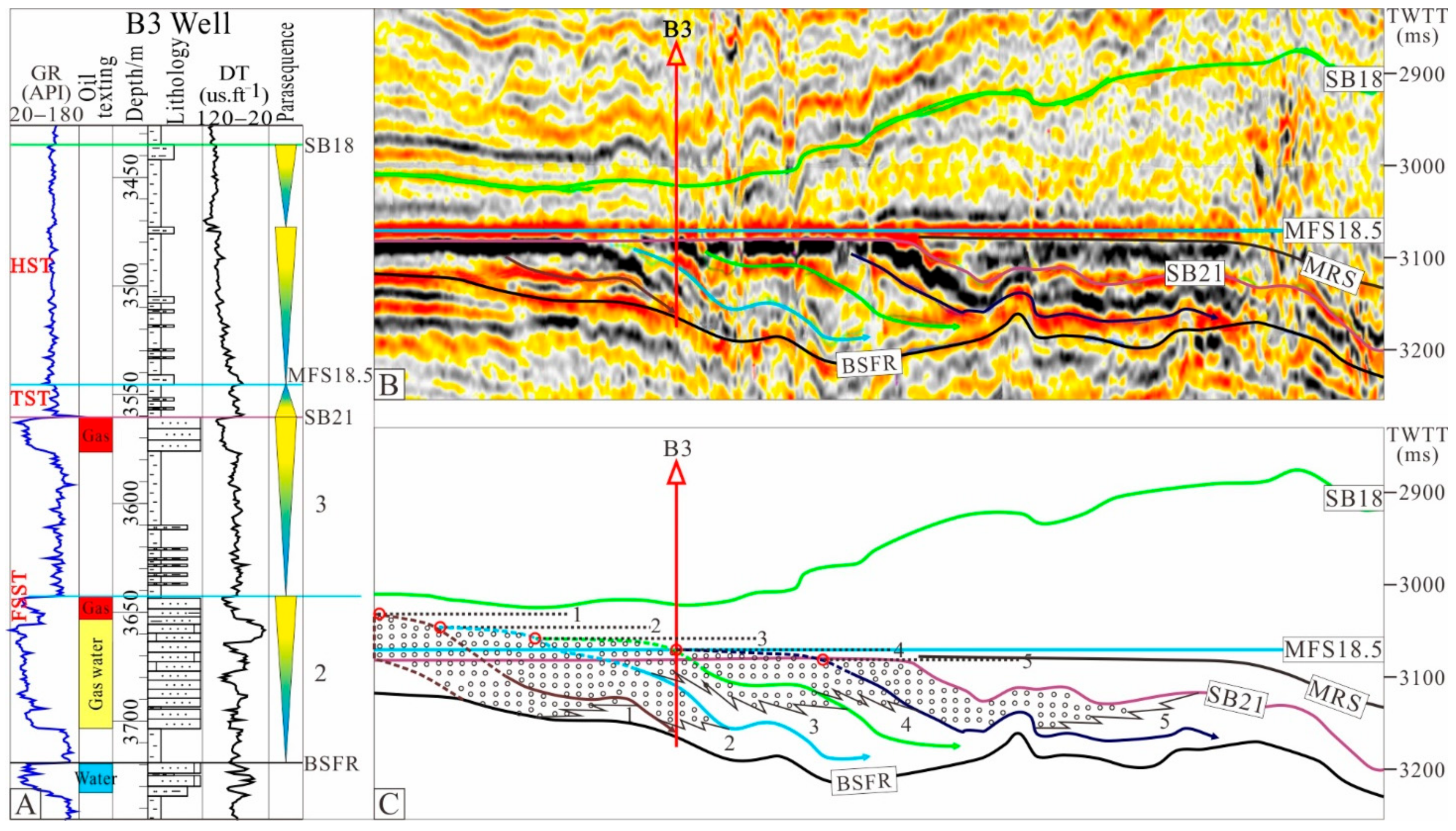
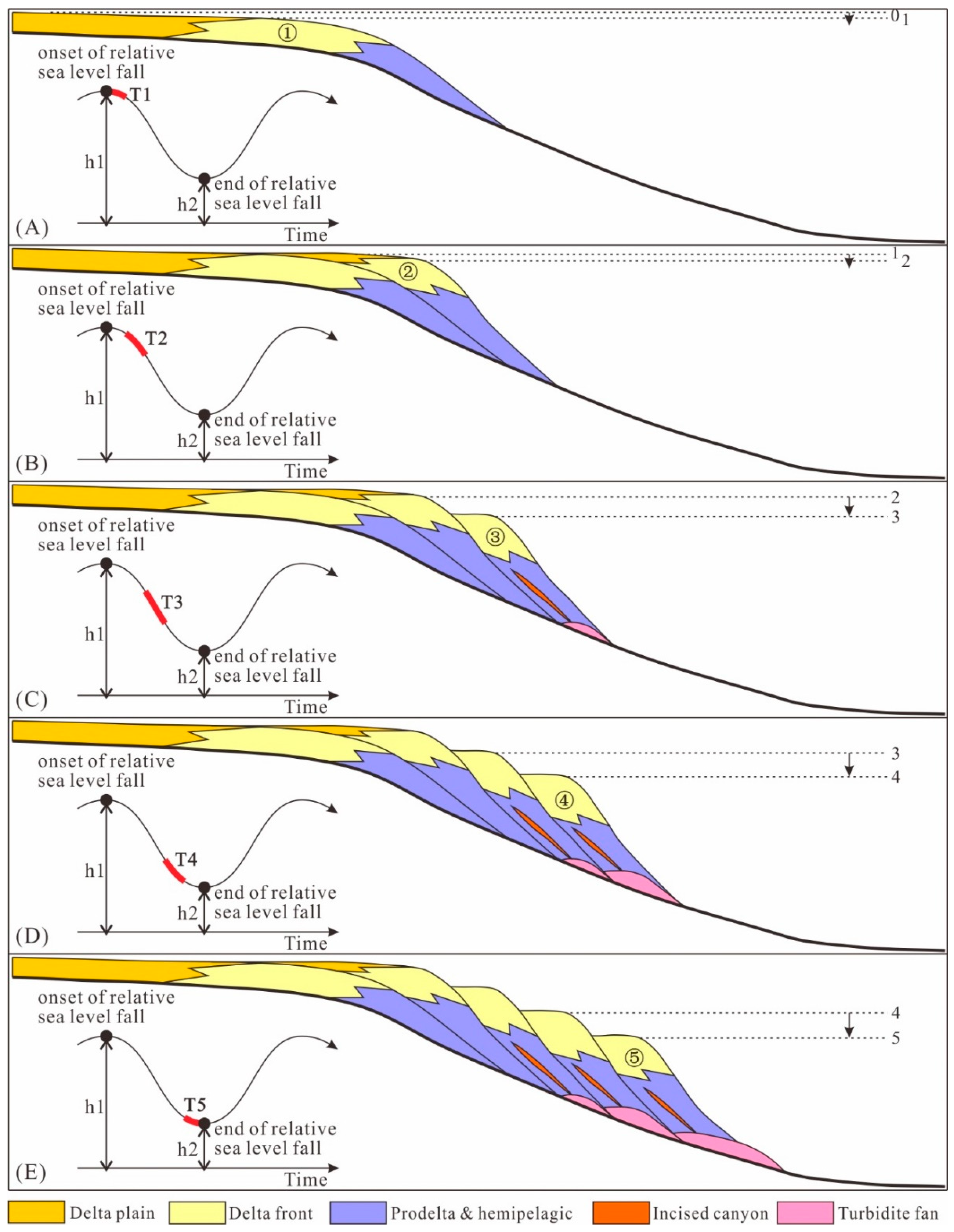

Publisher’s Note: MDPI stays neutral with regard to jurisdictional claims in published maps and institutional affiliations. |
© 2021 by the authors. Licensee MDPI, Basel, Switzerland. This article is an open access article distributed under the terms and conditions of the Creative Commons Attribution (CC BY) license (https://creativecommons.org/licenses/by/4.0/).
Share and Cite
Yu, Y.; Cai, L.; Zhang, C.; Wang, L.; Zhu, R.; Huang, Y.; Cao, T. Sedimentary Sequence, Evolution Model and Petroleum Geological Significance of Forced Regression: A Case Study of the Miocene Zhujiang Formation of the Pearl River Mouth Basin in the Northern South China Sea. J. Mar. Sci. Eng. 2021, 9, 1298. https://doi.org/10.3390/jmse9111298
Yu Y, Cai L, Zhang C, Wang L, Zhu R, Huang Y, Cao T. Sedimentary Sequence, Evolution Model and Petroleum Geological Significance of Forced Regression: A Case Study of the Miocene Zhujiang Formation of the Pearl River Mouth Basin in the Northern South China Sea. Journal of Marine Science and Engineering. 2021; 9(11):1298. https://doi.org/10.3390/jmse9111298
Chicago/Turabian StyleYu, Ye, Linghui Cai, Changmin Zhang, Li Wang, Rui Zhu, Yanran Huang, and Taotao Cao. 2021. "Sedimentary Sequence, Evolution Model and Petroleum Geological Significance of Forced Regression: A Case Study of the Miocene Zhujiang Formation of the Pearl River Mouth Basin in the Northern South China Sea" Journal of Marine Science and Engineering 9, no. 11: 1298. https://doi.org/10.3390/jmse9111298
APA StyleYu, Y., Cai, L., Zhang, C., Wang, L., Zhu, R., Huang, Y., & Cao, T. (2021). Sedimentary Sequence, Evolution Model and Petroleum Geological Significance of Forced Regression: A Case Study of the Miocene Zhujiang Formation of the Pearl River Mouth Basin in the Northern South China Sea. Journal of Marine Science and Engineering, 9(11), 1298. https://doi.org/10.3390/jmse9111298





